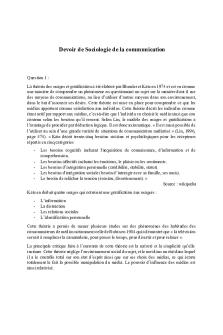Devoir a rendre-scarletletter PDF

| Title | Devoir a rendre-scarletletter |
|---|---|
| Course | Seminar on "The factory of worlds: literature and knowledge at the birth of modern science. 17th - 18th centuries" |
| Institution | Université Gustave-Eiffel |
| Pages | 2 |
| File Size | 70.7 KB |
| File Type | |
| Total Downloads | 39 |
| Total Views | 187 |
Summary
Download Devoir a rendre-scarletletter PDF
Description
A Flood of Sunshine
I)
A reject of the past
a) A strong contrast between past pains and present joy: “A crimson flush was glowing on her cheek, that had been long so pale” (opposition of colors, between the bleak past and the colourful present) b) “With this symbol I undo it all”: the scarlet letter thrown into the water as the symbolical pivot of the text, separating doubts and sorrow from relief and happiness (“The stigma gone, Hester heaved a long, deep sigh, in which the burden of shame and anguish departed from her spirit.”) c) A liberation: Hester “took off the formal cap that confined her hair”
II)
A strong description of passion and its power
a) Hester’s transfiguration: her beauty is enhanced by the happiness she is living, the text insists on a physical description of the character b) Dimmesdale’s transfiguration: relief and excitement
III)
A strong communion between humans and nature: the environment reflects human’s feelings and experiences, it expresses them)
a) The omnipresence of nature:“forth burst the sunshine”, “the obscure forest”, “each green leaf”, “the gray trunks of the solemn trees”, etc. b) Communication and harmony between human and their environment: “as if the gloom of the earth and sky had been but the effluence of these two mortal hearts, it vanished with their sorrow”; “love […] must always create a sunshine” c) The characters’ feelings are so strong that they have the power to exalt their environment; the beauty of nature becomes a symbol for the characters’ happiness and liberation (“Had the forest still kept its gloom, it would have been bright in Hester’s eyes”)
The procession
I)
The expression of human pain
a) Lexical field of pain: « another woe », « strange phantoms of guilt, sinkings of the heart, and unaccountable misfortune », « burden of shame and anguish » b) A text full of contrasts, enhanced by numerous binary constructions: “sweetness and power”, “loud or low expression”, “the whisper, or the shriek”
II)
Language’s power
a) Lexical field of language and voice throughout the text: “vocal organ”, “tone and cadence”, “volume”, “whisper”, “shriek” b) A personification of the preacher’s voice: “this vocal organ” becomes the subject of the first part of the text c) The power of the preacher’s voice: “that touched a sensibility in every bosom!”
III)
Religion as a new language for Hester
a) A deep and intimate connection: “Hester Prynne listened with such intenseness, and sympathized so intimately”; “until its volume seemed to envelop her with an atmosphere of awe and solemn grandeur” b) Identification to the preacher’s voice and words c) From incomprehension to revelation, and from words to sounds and feelings: as the preacher’s sermon becomes more and more meaningful throughout the text, it paradoxically loses its meaning -
The text begins with “a listener, comprehending nothing of the language in which the preacher spoke”; it is general and anonymous (“a listener”)
-
Then, the voice is described as understandable for anyone because of its musicality and intonations: “in a tongue native to the human heart”; it is compared to music (a form of language without words)
-
The text then focuses on Hester’s emotions and reactions to the preacher’s voice: “the sermon had throughout a meaning for her, entirely apart from its indistinguishable words”; “now she caught the low undertone”...
Similar Free PDFs

Devoir a rendre-scarletletter
- 2 Pages

Le devoir
- 4 Pages

Devoir Sociologie
- 2 Pages

Devoir 4 - Fashion Revolution
- 9 Pages

Devoir Ressources Halieutiques
- 6 Pages

Devoir 2 91%
- 3 Pages

Devoir maison à rendre
- 2 Pages

Devoir - Passé composé imparfait
- 2 Pages

Devoir AMP1 corrigé
- 5 Pages

Devoir individuel final - GIBSON
- 5 Pages

Week 3 - devoir maison
- 5 Pages

Littérature devoir maison
- 6 Pages
![Devoir L2[606]](https://pdfedu.com/img/crop/172x258/gwrwjggy4m21.jpg)
Devoir L2[606]
- 3 Pages

Devoir 1-gta
- 2 Pages

Devoir Histoire et Images
- 4 Pages
Popular Institutions
- Tinajero National High School - Annex
- Politeknik Caltex Riau
- Yokohama City University
- SGT University
- University of Al-Qadisiyah
- Divine Word College of Vigan
- Techniek College Rotterdam
- Universidade de Santiago
- Universiti Teknologi MARA Cawangan Johor Kampus Pasir Gudang
- Poltekkes Kemenkes Yogyakarta
- Baguio City National High School
- Colegio san marcos
- preparatoria uno
- Centro de Bachillerato Tecnológico Industrial y de Servicios No. 107
- Dalian Maritime University
- Quang Trung Secondary School
- Colegio Tecnológico en Informática
- Corporación Regional de Educación Superior
- Grupo CEDVA
- Dar Al Uloom University
- Centro de Estudios Preuniversitarios de la Universidad Nacional de Ingeniería
- 上智大学
- Aakash International School, Nuna Majara
- San Felipe Neri Catholic School
- Kang Chiao International School - New Taipei City
- Misamis Occidental National High School
- Institución Educativa Escuela Normal Juan Ladrilleros
- Kolehiyo ng Pantukan
- Batanes State College
- Instituto Continental
- Sekolah Menengah Kejuruan Kesehatan Kaltara (Tarakan)
- Colegio de La Inmaculada Concepcion - Cebu
